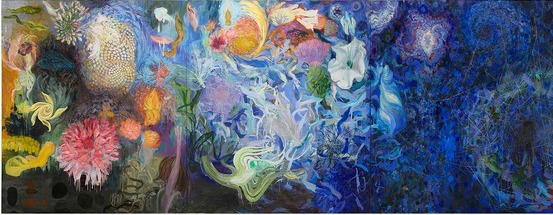Saturday is the day. That’s when the art world, which has been wondering what Don Bacigalupi, president of Crystal Bridges Museum of American Art, and assistant curator Chad Alligood have been seeing for the better part of 2013 and much of 2014 on their search for underappreciated artists, will find out. That’s when the museum unveils State of the Art: Discovering American Art Now — their selections. It is definitely an unconventional ride through art in America.
I say that even though I haven’t seen the show, though the press preview was today (I think), but I have gotten a little look. I have the illustrated checklist, and I’ve looked up several of the artists. I’ve also talked with Bacigalupi, talked with a couple of them, and selected five (which was really hard), to feature in an article. My piece, something of a curtain-raiser, is in Friday’s Wall Street Journal, Crystal Bridges Museum Gives Underappreciated Artists a National Show.
Though Bacigalupi says there were no quotas, the 102 artists selected were spread pretty evenly around the country: 24 from the Northeast, 25 from the South, 26 from the West and 27 from the Midwest. Most have an arts education — many with advanced degrees. Most have local “support systems.” Nonetheless, Bacigalupis said, “many said it was their first studio visit.â€
They picked 54 men and 48 women — even though Bacigalupi says they saw and spoke with more women artists than men. He acknowledges that “Not everyone will love everything in the show but I don’t think they should.†(A. Mary Kay’s painting is below; there are four additional artists’ works on the WSJ link.)
A key question: did they avoid controversial works? He says no. “We’re not avoiding anything…but communication has to be in two directions,” he told me. Or, to cite the quote I used in my article: “We wanted work that would engage people, not push them away, so even when artists here are asking tough questions, they are doing it in a way to open a conversation, not shut it down.” I don’t ever hear that from other curators or dealers.
I didn’t get into this in my story, but the exhibition doesn’t have a theme, and the curators didn’t divide their choices into afterthought themes either. So as you might imagine, “Hanging has been a challenge,” Bacigalupi told me. “You have to make the works cohere as an exhibit, communicate what these works are about.”
He said they hung the works with an eye to “conversations, connections, resonances – but not themes.” So instead of paragraphs of text introducing a gallery, providing context, Crystal Bridges will have “pithy wall texts that will help visitors into the conversation,† serving as “a point of departure.”
One gallery has these lines:
Human hands shape and frame the natural world.
Everyday stuff reveals grace and grit.
A stilled moment expands awareness.
Unexpected materials gain power and meaning.
Human bodies carry personal and historical significance.
Personal stories open avenues for empathy.
Another has these:
Materials and imagery can communicate heritage.
From a single image, complex tales unfold.
The stuff of daily life can reveal hidden stories.
Crystal Bridges also says that “There’s a great presence of the artists†in the didactics. In the catalogue. Bacigalupi wrote:
… one of the most meaningful things this project has presented is the opportunity to share much more about the artists themselves than a typical exhibition might. We hope that the faces of these artists, their voices and stories, the contexts and communities in which they make their art, and the intersections of their art and their lives will be rich additions to the guest experience. We want to incorporate as many of these layers as we can in our galleries, interpretive devices, and educational programs.
I imagine that some art world sophisticates will write off this show; I don’t think they should — at least not yet. I’m really looking forward to some thoughtful reviews.
Photo Credit: Courtesy of Crystal Bridges and A. Mary Kay

